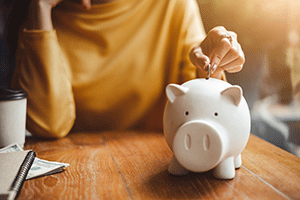Reviewed by: Jo-El Gonzalez
For many people, tax season brings a slew of mixed emotions. Amid the anxiety of gathering all of your W2s and tax receipts, a reason to celebrate knowing you'll likely receive a refund. If you’re getting a significant amount of money returned, you should consider investing or using it to benefit your financial future. It’s OK if you decide to plan a vacation or big-ticket item, but consider these options first.

The key here is to reduce your taxable income. This, in turn, will boost your refund. Start by maxing out your traditional IRA contribution. You have until April 15 to open or contribute for the previous tax year. If you’re self-employed, you have until October 15 to contribute if you file an extension. These funds are sheltered from taxes until you need them, typically in retirement.
An HSA (Health Savings Account) allows you to make pre-tax contributions, reducing your taxable income. You can make these up until the filing deadline. Consult with your health insurance provider before contributing to your HSA to learn all the features and benefits.
Review and recheck your available tax deductions. Commonly overlooked deductions include state sales tax, dividends, student loans, and childcare. In addition, up to $6,000 of qualifying expenses can be used for the Child and Dependent Care Credit.
If you’re self-employed, consider any business purchases that can qualify for deductions, like office equipment. Likewise, consider any medical procedures or exams you have planned, and be sure to schedule them at the end of the year.
Review any tax credits you may have missed, including education credits for students and parents of college students, the earned income tax credit, and energy-saving home improvements.
Whether or not you can get an extra deduction for this year, investing for the future is always a good thing. You can get ahead on next year’s IRA contributions, open a taxable brokerage account, or leave the money in your checking account so you can boost your 401(k) contributions at work. If you choose a tax-deductible retirement account, that will help you increase your refund next year. A financial advisor can help you understand your financial situation and plan for the future.
Do you have enough savings to cover unexpected car or home repairs, medical bills, or job loss? If not, putting your tax return into a personal savings account is a smart move. Set a goal to save enough money to support you and your family for six months financially, should you need it. If you’re unsure of your monthly expenses, use these tips to create a personal budget.
A CD (Certificate of Deposit) is another good option if you want to increase your potential interest earnings. CDs give you a higher rate for locking your money in for a fixed number of months. If you build a CD ladder, you can spread out when your CDs mature, so you always have a little extra money available if you need it and can roll it back into a CD if you don’t. Different savings accounts come with various features and withdrawal limits, so compare savings accounts to find the best option for your lifestyle.
Should you consider using your tax refund to pay off your debt? Absolutely! Paying down debt is another great option since you get a guaranteed return equal to the interest you’re saving. So pick your credit card or loan with the highest interest rate, and put your tax refund towards it.
One catch is that you might want to build up your emergency fund first, especially if your debt is a lower-interest-rate car loan or mortgage. This could help you to avoid running up higher-interest credit card debt if you have an unexpected expense or leave you with money to keep making your mortgage payments if you lose your job.
Consider using your tax refund on the larger home purchases you’ve been putting off, such as appliances, a new roof, or energy-efficient improvements. This will allow you to avoid financing these more significant purchases and wrack up costly interest charges. Your tax refund is also great for kickstarting a larger home improvement remodel. A Home Equity Line of Credit, or HELOC, is a great alternative to a home improvement loan and is the next logical step depending on the size of your project.
 If you don’t have an immediate use for your tax return, consider retirement planning as a great way to invest these funds and maximize your savings. Start by setting up a personal IRA and creating a financial plan that establishes your target retirement age and income level. This will help you determine how much money you need to save annually and can boost your future tax refunds by reducing your taxable income.
If you don’t have an immediate use for your tax return, consider retirement planning as a great way to invest these funds and maximize your savings. Start by setting up a personal IRA and creating a financial plan that establishes your target retirement age and income level. This will help you determine how much money you need to save annually and can boost your future tax refunds by reducing your taxable income.
Keep in mind that your tax refund is from you paying the IRS too much in taxes during the year. Instead of giving the government an interest-free loan, you may want to put your money to work for you sooner, so you’re the one earning interest on it. To do so, consider reducing your tax withholding and then budget the extra money from each paycheck towards wherever you invest your tax refund.
Seacoast Bank has a variety of savings account solutions to help your tax refund stretch further. Compare our saving solutions here or connect with a local banker using the form below to learn more.
Topics: Manage Your Money, Financial Wellness
Are you interested in contacting a local, Florida banker to discuss your individual financial needs? We’d love to speak with you. Schedule a consultation today.
Share: